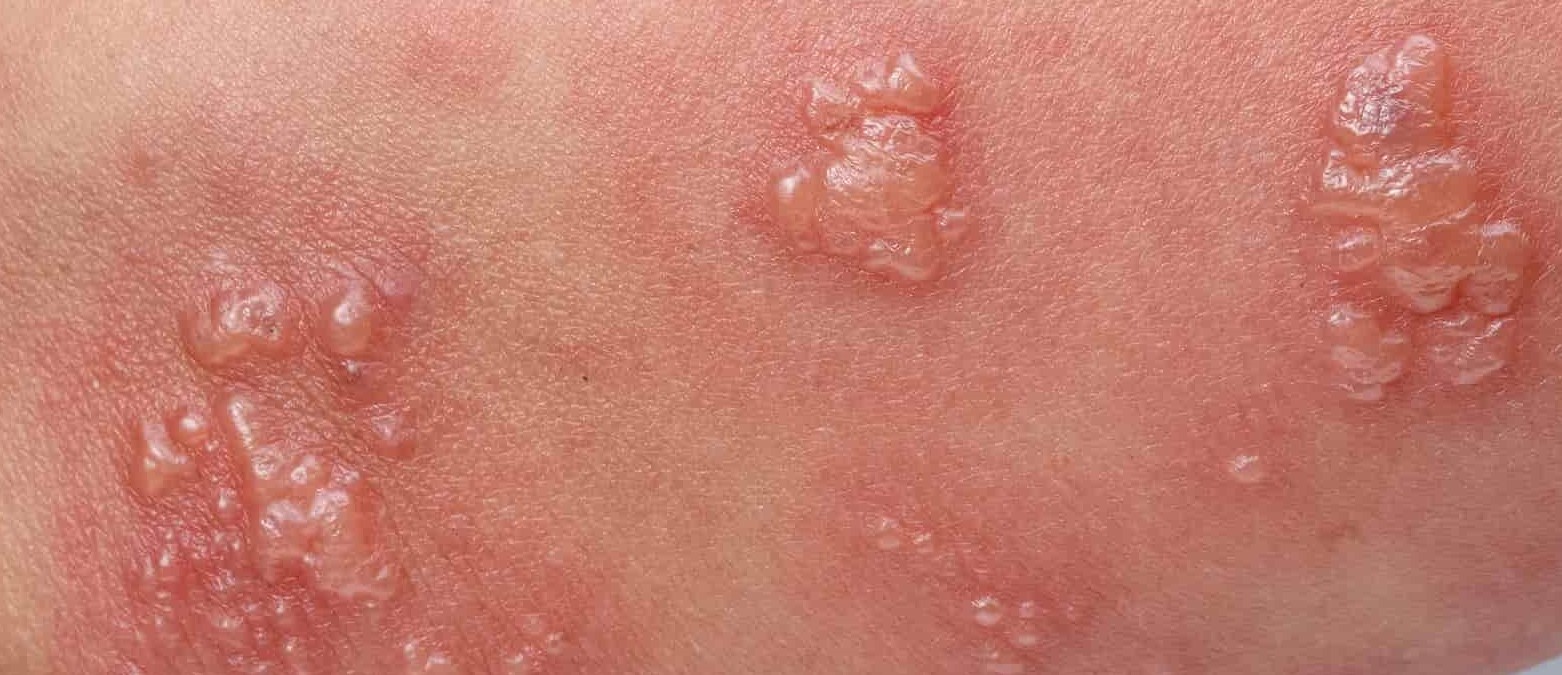What Does Herpes Look Like?

Content by

Last Updated
Table of Contents
- What does genital herpes look like?
- What does the beginning of genital herpes look like?
- What does a genital herpes outbreak look like?
- What does genital herpes look like when it is healing?
- What does herpes look like in a man?
- What does herpes look like in a woman?
- What does mouth herpes look like?
- Herpes vs. pimples – What’s the difference?
- Sores that look like herpes but are not
- How to treat herpes
The herpes simplex virus is a common sexually transmitted infection (STI) caused by the herpes simplex virus type 1 (HSV-1) and herpes simplex virus type 2 (HSV-2).
HSV-1 often causes oral herpes and typically results in the appearance of cold sores or fever blisters, on or around the mouth. While the herpes simplex virus 1 can cause genital herpes, it is most commonly associated with oral herpes.
The World Health Organisation (WHO) estimates that 3.7 billion people under the age of 50 have HSV-1 infection globally. Most people infected with oral herpes are asymptomatic, and many contract the virus during childhood or young adulthood after coming in non-sexual contact with saliva. Oral herpes can be spread from contact with a herpes sore, or saliva from an individual with an oral herpes infection.
HSV-2 infection predominantly affects the genitals. Similar to HSV-1 infection, many people living with the virus experience mild symptoms, while others are asymptomatic. Mild symptoms may go unnoticed or be mistaken for other ailments, such as ingrown hairs or pimples. The WHO indicates that an estimated 491 million people between the ages of 15-49 are infected with HSV-2 globally. Those living with symptomatic genital herpes will experience breakouts on the sex organs, as well as the rectum, anus, or thighs.
Genital herpes is spread through vaginal, anal, or oral sex from an infected individual, or contact with the genital fluid of someone with herpes. Skin-to-skin contact in the oral area of a partner with oral herpes or the genital area of a partner with genital herpes may also result in the transmission of the virus.
What does genital herpes look like?
Genital herpes looks like white sores with a fluid filled centre. The edges of the spots and surrounding area is usually red. The early onset of genital herpes can present in a number of different ways. Itching or a tingling sensation is commonly associated with the onset of an outbreak.
The initial outbreak following infection is usually the worst and may result in the emergence of flu-like symptoms. Fever, headaches, and swollen lymph nodes are common, and pain in the legs, back, buttocks or hips may also occur.
What does the beginning of genital herpes look like?
The onset of symptoms typically occurs within 1-2 weeks of infection. This stage is identified as the prodrome or beginning stage, as the appearance of inflammation indicates the virus has progressed to the surface of the skin.
Men may feel a burning sensation when urinating if an outbreak of genital herpes occurs in the urethra. Women experiencing an HSV-2 outbreak may also deal with painful urination as well as unusual vaginal discharge. Inflammation of the cervix may also indicate genital herpes infection.
The itching or tingling sensation in the genital areas signifies the progression of the virus, as it travels from the ganglia directly adjacent to the spinal rope in the lower back, to the surface of the skin via nerve paths. Since the nerves in the genitals, upper thighs and buttocks are linked, a genital herpes outbreak can occur in any of these regions.
What does a genital herpes outbreak look like?
A genital herpes outbreak that has reached the blisters stage results in the emergence of blisters or sores. Genital herpes sores look like small red spots, which appear in clusters, and eventually progress to fill with a clear to whitish fluid. These bumps are extremely sensitive and may cause pain or discomfort for infected individuals. Individual blisters within a cluster may vary in size, with some no larger than a pinhead, while others may grow to the size of a pea.
The skin surrounding the lesions will often become raised, red, and sensitive. Similar to the appearance of razor burn, jock itch or pimples, herpes at the sores stage can be difficult to accurately distinguish, although the cluster formation usually provides the key differentiation that can aid in diagnosing.
Although the fever associated with the prodrome stage could persist in this phase of infection, it is typically only noted during an initial herpes breakout.
Once the blisters burst and begin to drain, the infection has progressed to the ulcer stage. These open sores develop in the location where the blister was. Ulcers are marked by their pinkish to reddish tone, from which ooze or fluid or blood will emerge. This stage is often more uncomfortable than when the blisters are forming, and the pain associated with the ulcers is exacerbated by contact with uncomfortable clothing or other irritants.
What does genital herpes look like when it is healing?
Over time, the ulcers will develop a yellowish fluid which will harden to form a scab over the sore. The sores will eventually crust over and heal, before eventually falling off. Herpes sores at this stage take on the appearance of a crust-lined scab which is a distinct yellowish colour due to the hardening of the fluid. The skin surrounding healing herpes sores may still appear somewhat red and irritated.
Picking at the crust or scabs may result in bleeding or scarring. Genital herpes sores can take between two and four weeks to heal – although moist areas such as the vagina can take longer, as the ability for the lesions to dry out is more difficult.
What does herpes look like in a man?
While the sores associated with a genital herpes outbreak are similar between men and women, the areas affected differ. Men who experience a genital herpes outbreak may suffer a rash of blisters on the penis shaft, head, scrotum and testicles.
The tip of the penis and shaft are very sensitive areas of the body, and men suffering from an outbreak here will find touching the penis to be painful during this time.
The scrotum is another sensitive area that can be affected by a genital herpes outbreak. Herpes on the scrotum affects not only the skin of the sheath of the scrotum, but the entirety of the seven layers that envelop them. Since the herpes simplex virus travels on the body’s nerve paths to the surface of the skin, each layer from the superficial fascia down to the peritoneum of the scrotum may be affected.
Many men worry that a genital herpes outbreak on the testicles will affect their fertility. The National Library of Medicine (NIH) has reported a study linking genital herpes to a reduction in sperm count, although no concrete evidence of a direct correlation to HSV-2 making men sterile exists.
What does herpes look like in a woman?
Due to the nature of the female reproductive organs, the ulcer stage of a genital herpes outbreak in women can take longer to heal. Whereas the penis remains dry, the vagina typically remains moist, affecting the progression of the crust necessary to facilitate the healing process.
The vulva, or external sex organ of the female body is one of the few areas where blisters may be visible to the naked eye. Early stages of an HSV-2 outbreak may be more difficult for women to detect as a result.
The vaginal opening can experience discomfort or irritation in advance of a genital herpes outbreak. Herpes on the vagina may result in the colour surrounding the area reddening, or a rash may form on or around the vagina lip. Lesions such as sores and ulcers of the vagina caused by a herpes outbreak typically last between one to two weeks.
Herpes inside the vagina is often undetectable and at times, confused for other STIs that cause inflammation, such as gonorrhoea. The Centers for Disease Control and Prevention (CDC) detail the similarities between the two STIs which could mask correct identification of the cause of inflammation.
What does mouth herpes look like?
An oral herpes outbreak is commonly associated with the emergence of blisters on the lips or mouth. Lesions may also surface inside the mouth. Like other moist areas, sores inside the mouth typically take longer to crust over and heal.
Both HSV-1 and HSV-2 can infect the mouth and lips. Blisters last between seven to ten days, beginning as a cluster of fluid-filled blisters that rupture within a few days of emergence.
Oral herpes may often manifest on the corner of the lips in a honeycomb-like cluster, or as a single large cold sore. The outbreak may remain isolated to one spot on the upper or lower lip, or inside the mouth, or may spread across multiple skin surfaces.
During the blister stage, the bumps are a reddish colour, and will take a yellowish tinge once the lesions have burst in the ulcer stage. The healing process is indicated by the crust-like appearance that eventually overtakes the open sores.
Herpes vs. pimples – What’s the difference?
For those who are unaware of a herpes infection, the initial outbreak is commonly confused for a pimple or ingrown hair. Both pimples and genital herpes present as clusters of red bumps on the surface of the affected skin.
Appearance
Pimples and herpes are both identified by raised, raw blister-like sores that begin to fill with a pus-like substance. Both are also sensitive to the touch and feel itchy and irritated. As with genital herpes, pimples can emerge on the buttocks, thighs, and sex organs.
Despite several similarities, there are some distinguishing characteristics between pimples and herpes lesions.
|
Herpes |
Pimples |
| Sensation of tingling before the appearance of herpes blisters | May not be as effective as its counterparts |
| Clear, fluid-filled vesicles | Will be red, or filled with pus |
| Usually appear around the mouth, lip and genitals | Usually appear around the nose, cheeks, forehead, chest, back |
| May appear in clusters | Usually occur as single bumps |
| Vesicles are fluid-filled and eventually burst | |
| Sores will crust over after they have burst |
Discharge
Resulting in the accumulation of bacteria inside clogged pores, pimples fill with thick white pus that turns darker when exposed to air. They may also bleed or leak a thick white fluid when irritated or scratched.
Herpes blisters fill with a clear whitish fluid that eventually turns a yellowish tinge after a sore has been ruptured. Typically, discharge from herpes sores is less thick than the pus that emerges from a popped pimple. Penile or vaginal discharge caused by genital herpes is often thicker and can vary from whitish to yellowish colour. A strong, fish-like odour is at times associated with genital herpes discharge from the sex organs.
Area
As with an oral or genital herpes outbreak, acne pimples can occur in the same areas. On the face – particularly the skin surrounding the lips of an infected person, the two types of blisters may be difficult to differentiate. Both herpes and pimples can break out near the eyes.
Genital herpes affects areas in contact with the nerve paths that they travel upon. The thighs, buttocks, penis, and vagina share these pathways, and restrictive clothing or other irritants may also clog the pores of the sensitive skin in these areas. As a result, both pimples and herpes lesions may appear here.
Accompanying symptoms
The associated symptoms of an acne pimple breakout vary depending on the severity of the condition. Whiteheads and blackheads are the result of clogged pores, while papules and pustules are red and tender bumps that – in the case of the latter – result in pus-filled tips that are painful to the touch. Exacerbated pimples can form large, solid, and painful lumps under the skin, or pus-filled blisters that remain under the surface of the skin, known as cystic lesions.
Genital herpes symptoms vary depending on the severity of the outbreak, with the initial flare-up after contracting the virus being the worst. Flu-like symptoms and body pain are often precursors to the emergence of an itchy, tingling rash. The blisters stage is accompanied by sensitivity to the skin of the surrounding area, and pain associated with healing ulcers in the mouth or on the genitals can cause discomfort until fully healed.
Testing
As pimples are not attributed to a particular virus or bacteria, there is no test to determine their emergence. Herpes can be tested by swabbing fluid from an opened sore. As a result, infected individuals must wait until the blister or ulcer stage of the virus to accurately diagnose the emergence of the STD.
Despite the need for pronounced blisters to determine infection, if you suspect that you may be experiencing the early symptoms of a herpes outbreak you should contact a healthcare provider.
Sores that look like herpes but are not
Many ailments and conditions are similar in appearance to a herpes rash. While determining the difference between herpes, pimples, ingrown hairs, and other sexually transmitted infections (STIs) can be difficult, there are some subtle distinctions that can aid in detection.
Genital warts
As defined by the Centers for Disease Control and Prevention (CDC), Human papillomavirus (HPV) is among the most common STIs in the world. Certain strains of HPV cause genital warts. Similar to herpes, genital warts can appear as a small cluster of bumps. The warts may vary in size and appearance but are often flesh-coloured, raised and cauliflower-shaped.
Genital warts may form on the penis, scrotum, thighs, and lips. Females may develop warts on the walls of the vagina and cervix and inside the mouth or throat. Warts are typically painless, although sex may irritate them, resulting in an itching sensation or light bleeding.
Genital warts may emerge between six weeks and six months after contracting HPV, although some individuals may be asymptomatic.
Syphilis
Unlike herpes which cannot be cured, syphilis can be easily cured if treated in time. However, unlike herpes, syphilis can have devastating long-term effects if left untreated. The CDC details the four stages of syphilis, and how the small bumps the condition first presents are similar to herpes blisters. Unlike herpes, syphilis lesions are painless. Both conditions can affect the penis, vagina, anus, and mouth. Syphilis sores are usually round and firm, and last three to six weeks. Secondary stage infections may result in rashes that show up on the palms of the hands or bottom of the feet.
Folliculitis
Folliculitis, a condition commonly distinguished by an infected ingrown hair, is often mistaken for herpes. As detailed by the Cleveland Clinic bacteria – frequently Staphylococcus Aureus – enters the hair follicle through a small pimple that has developed around it. Areas surrounding both the mouth and genitals may be irritated or affected by ingrown hairs as a result of shaving or grooming.
Bacterial vaginosis (BV)
BV is an imbalance of the normal bacteria universe in the vagina. The CDC indicates that while BV is not considered a sexually transmitted infection (STI), it can increase a woman’s risk of contracting one.
How to treat herpes
Whilst there is no cure, genital herpes treatment can be used in two ways:
- Outbreak treatment: To reduce the length and severity of an outbreak
- Suppression treatment: Taken long term to reduce the chances of experiencing an outbreak
The two main antiviral treatment used for herpes are aciclovir tablets and valaciclovir tablets.
Outbreak Treatment
Outbreak treatment is used at the start of an outbreak during the prodrome phase. It can help to heal sores faster, and reduce pain associated with an outbreak.
Aciclovir dose: One 400mg tablet taken three times a day for five days
Valaciclovir dose: One 500mg tablet taken twice a day for five days
Suppression Treatment
Aciclovir dose: One 400mg tablet to be taken twice daily long term
Valaciclovir dose: One 500mg tablet to be taken once daily long term
Whilst all of our content is written and reviewed by healthcare professionals, it is not intended to be substituted for or used as medical advice. If you have any questions or concerns about your health, please speak to your doctor.
